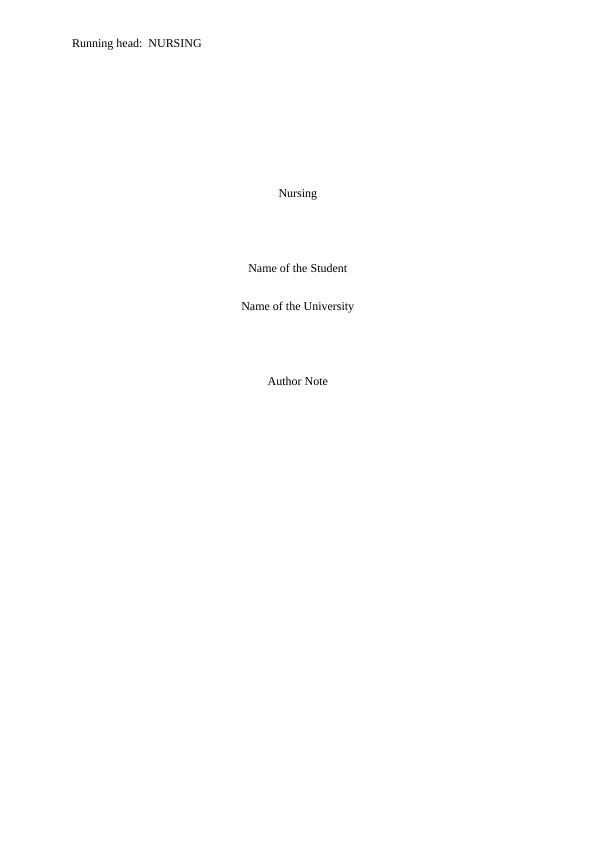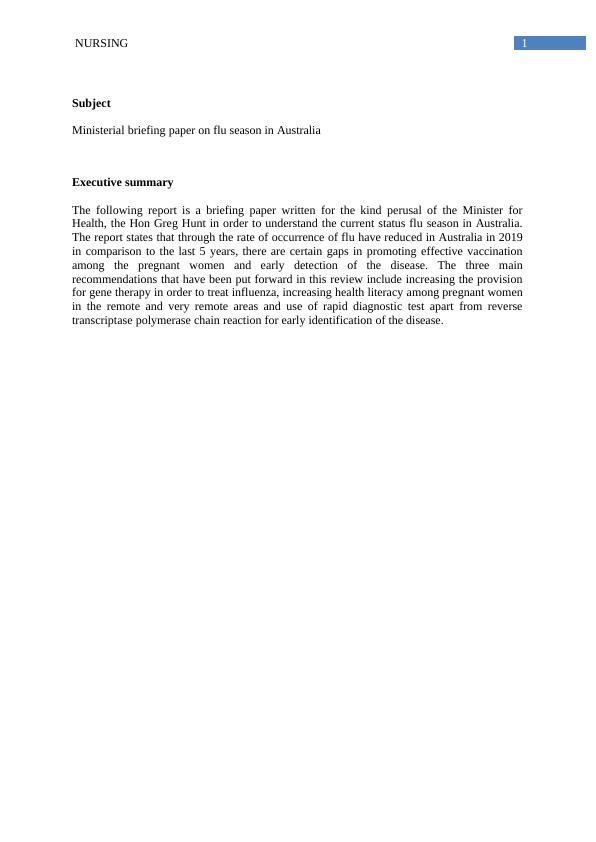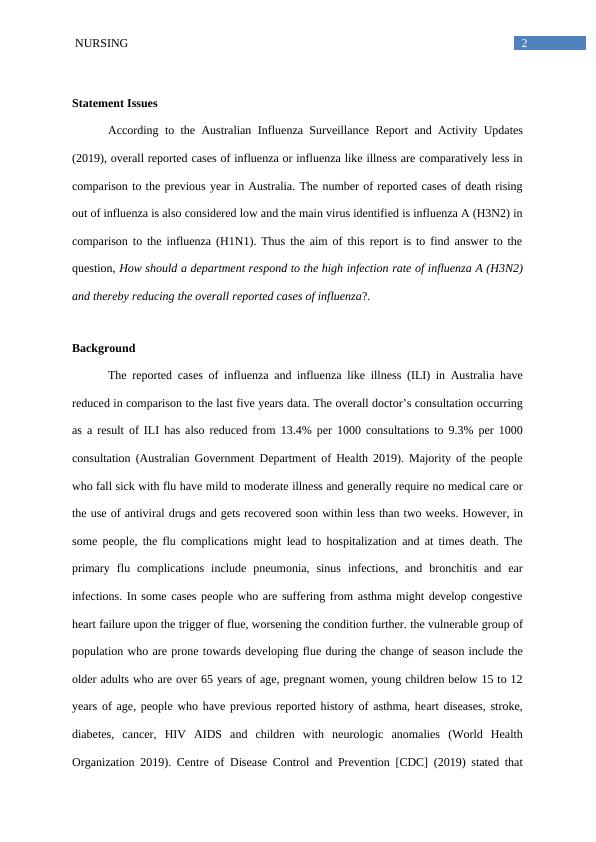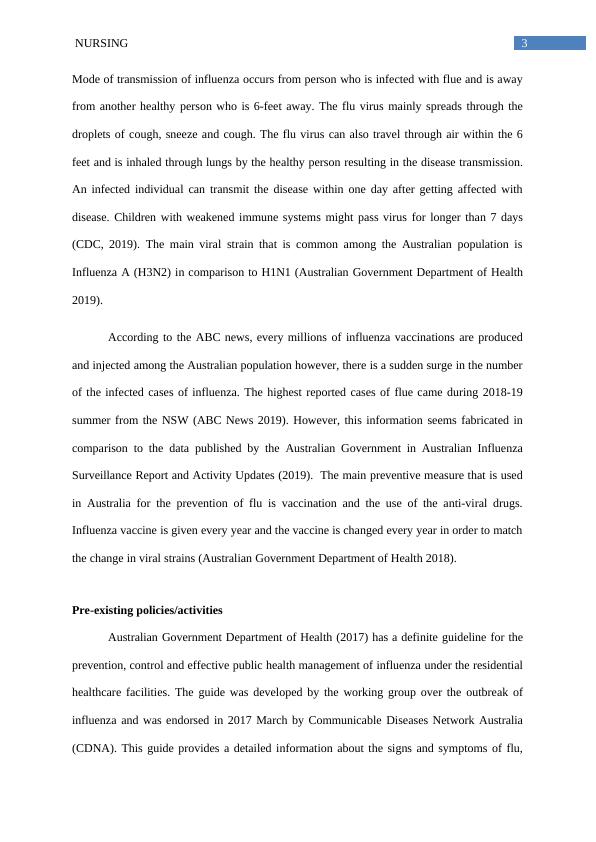Ministerial Briefing Paper on Flu Season in Australia
Added on 2022-12-19
14 Pages3397 Words85 Views
Running head: NURSING
Nursing
Name of the Student
Name of the University
Author Note
Nursing
Name of the Student
Name of the University
Author Note

1NURSING
Subject
Ministerial briefing paper on flu season in Australia
Executive summary
The following report is a briefing paper written for the kind perusal of the Minister for
Health, the Hon Greg Hunt in order to understand the current status flu season in Australia.
The report states that through the rate of occurrence of flu have reduced in Australia in 2019
in comparison to the last 5 years, there are certain gaps in promoting effective vaccination
among the pregnant women and early detection of the disease. The three main
recommendations that have been put forward in this review include increasing the provision
for gene therapy in order to treat influenza, increasing health literacy among pregnant women
in the remote and very remote areas and use of rapid diagnostic test apart from reverse
transcriptase polymerase chain reaction for early identification of the disease.
Subject
Ministerial briefing paper on flu season in Australia
Executive summary
The following report is a briefing paper written for the kind perusal of the Minister for
Health, the Hon Greg Hunt in order to understand the current status flu season in Australia.
The report states that through the rate of occurrence of flu have reduced in Australia in 2019
in comparison to the last 5 years, there are certain gaps in promoting effective vaccination
among the pregnant women and early detection of the disease. The three main
recommendations that have been put forward in this review include increasing the provision
for gene therapy in order to treat influenza, increasing health literacy among pregnant women
in the remote and very remote areas and use of rapid diagnostic test apart from reverse
transcriptase polymerase chain reaction for early identification of the disease.

2NURSING
Statement Issues
According to the Australian Influenza Surveillance Report and Activity Updates
(2019), overall reported cases of influenza or influenza like illness are comparatively less in
comparison to the previous year in Australia. The number of reported cases of death rising
out of influenza is also considered low and the main virus identified is influenza A (H3N2) in
comparison to the influenza (H1N1). Thus the aim of this report is to find answer to the
question, How should a department respond to the high infection rate of influenza A (H3N2)
and thereby reducing the overall reported cases of influenza?.
Background
The reported cases of influenza and influenza like illness (ILI) in Australia have
reduced in comparison to the last five years data. The overall doctor’s consultation occurring
as a result of ILI has also reduced from 13.4% per 1000 consultations to 9.3% per 1000
consultation (Australian Government Department of Health 2019). Majority of the people
who fall sick with flu have mild to moderate illness and generally require no medical care or
the use of antiviral drugs and gets recovered soon within less than two weeks. However, in
some people, the flu complications might lead to hospitalization and at times death. The
primary flu complications include pneumonia, sinus infections, and bronchitis and ear
infections. In some cases people who are suffering from asthma might develop congestive
heart failure upon the trigger of flue, worsening the condition further. the vulnerable group of
population who are prone towards developing flue during the change of season include the
older adults who are over 65 years of age, pregnant women, young children below 15 to 12
years of age, people who have previous reported history of asthma, heart diseases, stroke,
diabetes, cancer, HIV AIDS and children with neurologic anomalies (World Health
Organization 2019). Centre of Disease Control and Prevention [CDC] (2019) stated that
Statement Issues
According to the Australian Influenza Surveillance Report and Activity Updates
(2019), overall reported cases of influenza or influenza like illness are comparatively less in
comparison to the previous year in Australia. The number of reported cases of death rising
out of influenza is also considered low and the main virus identified is influenza A (H3N2) in
comparison to the influenza (H1N1). Thus the aim of this report is to find answer to the
question, How should a department respond to the high infection rate of influenza A (H3N2)
and thereby reducing the overall reported cases of influenza?.
Background
The reported cases of influenza and influenza like illness (ILI) in Australia have
reduced in comparison to the last five years data. The overall doctor’s consultation occurring
as a result of ILI has also reduced from 13.4% per 1000 consultations to 9.3% per 1000
consultation (Australian Government Department of Health 2019). Majority of the people
who fall sick with flu have mild to moderate illness and generally require no medical care or
the use of antiviral drugs and gets recovered soon within less than two weeks. However, in
some people, the flu complications might lead to hospitalization and at times death. The
primary flu complications include pneumonia, sinus infections, and bronchitis and ear
infections. In some cases people who are suffering from asthma might develop congestive
heart failure upon the trigger of flue, worsening the condition further. the vulnerable group of
population who are prone towards developing flue during the change of season include the
older adults who are over 65 years of age, pregnant women, young children below 15 to 12
years of age, people who have previous reported history of asthma, heart diseases, stroke,
diabetes, cancer, HIV AIDS and children with neurologic anomalies (World Health
Organization 2019). Centre of Disease Control and Prevention [CDC] (2019) stated that

3NURSING
Mode of transmission of influenza occurs from person who is infected with flue and is away
from another healthy person who is 6-feet away. The flu virus mainly spreads through the
droplets of cough, sneeze and cough. The flu virus can also travel through air within the 6
feet and is inhaled through lungs by the healthy person resulting in the disease transmission.
An infected individual can transmit the disease within one day after getting affected with
disease. Children with weakened immune systems might pass virus for longer than 7 days
(CDC, 2019). The main viral strain that is common among the Australian population is
Influenza A (H3N2) in comparison to H1N1 (Australian Government Department of Health
2019).
According to the ABC news, every millions of influenza vaccinations are produced
and injected among the Australian population however, there is a sudden surge in the number
of the infected cases of influenza. The highest reported cases of flue came during 2018-19
summer from the NSW (ABC News 2019). However, this information seems fabricated in
comparison to the data published by the Australian Government in Australian Influenza
Surveillance Report and Activity Updates (2019). The main preventive measure that is used
in Australia for the prevention of flu is vaccination and the use of the anti-viral drugs.
Influenza vaccine is given every year and the vaccine is changed every year in order to match
the change in viral strains (Australian Government Department of Health 2018).
Pre-existing policies/activities
Australian Government Department of Health (2017) has a definite guideline for the
prevention, control and effective public health management of influenza under the residential
healthcare facilities. The guide was developed by the working group over the outbreak of
influenza and was endorsed in 2017 March by Communicable Diseases Network Australia
(CDNA). This guide provides a detailed information about the signs and symptoms of flu,
Mode of transmission of influenza occurs from person who is infected with flue and is away
from another healthy person who is 6-feet away. The flu virus mainly spreads through the
droplets of cough, sneeze and cough. The flu virus can also travel through air within the 6
feet and is inhaled through lungs by the healthy person resulting in the disease transmission.
An infected individual can transmit the disease within one day after getting affected with
disease. Children with weakened immune systems might pass virus for longer than 7 days
(CDC, 2019). The main viral strain that is common among the Australian population is
Influenza A (H3N2) in comparison to H1N1 (Australian Government Department of Health
2019).
According to the ABC news, every millions of influenza vaccinations are produced
and injected among the Australian population however, there is a sudden surge in the number
of the infected cases of influenza. The highest reported cases of flue came during 2018-19
summer from the NSW (ABC News 2019). However, this information seems fabricated in
comparison to the data published by the Australian Government in Australian Influenza
Surveillance Report and Activity Updates (2019). The main preventive measure that is used
in Australia for the prevention of flu is vaccination and the use of the anti-viral drugs.
Influenza vaccine is given every year and the vaccine is changed every year in order to match
the change in viral strains (Australian Government Department of Health 2018).
Pre-existing policies/activities
Australian Government Department of Health (2017) has a definite guideline for the
prevention, control and effective public health management of influenza under the residential
healthcare facilities. The guide was developed by the working group over the outbreak of
influenza and was endorsed in 2017 March by Communicable Diseases Network Australia
(CDNA). This guide provides a detailed information about the signs and symptoms of flu,

End of preview
Want to access all the pages? Upload your documents or become a member.
Related Documents
Epidemiology: Influenzalg...
|12
|3013
|52
Human Respiratory Pathogens Nursing Assignment 2022lg...
|10
|2876
|22
Vaccinations are effective and safelg...
|9
|2471
|13
ASSIGNMENT ON SURVEILLANCE HOMEWORK.lg...
|10
|2160
|17
Evaluation of Annual Influenza Vaccination for Older Adults and Community Nurseslg...
|10
|2934
|151
Child and Adolescent Healthlg...
|10
|2668
|81
